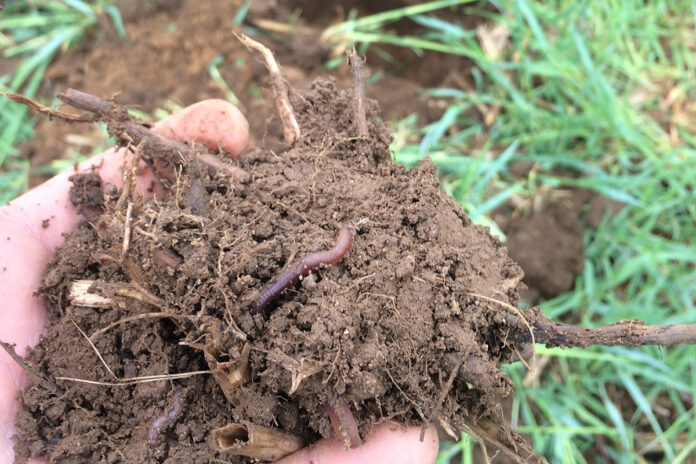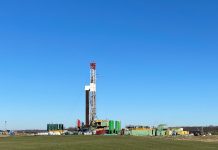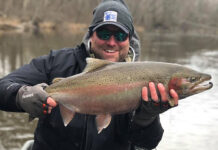
By Heather Neikirk
This week brought many of us varying degrees of that old-fashioned “white stuff” letting us know that the winter season will quickly be upon us.
One of my favorite activities in winter is to spend a few peaceful and silent moments during or just after an accumulating snowfall, taking in the beauty and silence of my natural surroundings, especially the grazing landscape of our small farm. It is also a time for me to remind myself that beneath the beauty and silence of the covered surface is a dynamic system at work. A multi-faceted ecosystem is alive, actively cycling nutrients through the many channels of the soil food web.
Winter is traditionally less focused on surface activities related to our pasture and more on livestock care, equipment repair, planning and self-rejuvenation in preparation for spring.
Our pasture ecosystem is silently doing the same thing, cycling nutrients to care for plants, providing fuel for working microbes and regenerating the soil and plants in anticipation of livestock grazing.
Building healthy, regenerative pasture soils
The key to building a regenerative, healthy pasture system is to understand that soil fertility is more than just interpreting soil sample analyses, fertilizing and providing the necessary nutrients for a productive pasture/grazing system.
Soil fertility is instead a complex, holistic ecosystem that requires adaptive management practices beyond conservation. It requires observation and the use of both healthy and unhealthy indicators (aggregation and cover versus compaction and bare ground) of the complete system.
Soil fertility in a regenerative system means that we ensure that all participants in the soil food web have habitat and fuel, especially the microbial residents.
These residents are the ones who will contribute most effectively and efficiently to building soil health and a sustainable soil fertility ecosystem.
To better understand the dynamic state of pasture/grazing systems, let’s explore a couple of key concepts presented in two sustainable agriculture educational bulletins from the National Center for Appropriate Technology’s program on Appropriate Technology Transfer for Rural Areas.
Nutrient cycling in pastures
Nutrient cycles are interconnected. They do not operate in a vacuum, independent of one another or in concisely drawn diagrams. Rather, they operate simultaneously and with each other. Nutrient cycles also interact with a diversity of organism life cycles. These interactions within and above the soil provide fuel and drive the movement of all plant nutrients.
In pastures, nutrient cycling is dependent upon photosynthesis and microbes. Simply put, sunlight is captured by plants via photosynthesis and processed into energy by plants. The plant transfers this energy to the roots where it is released (exuded) as simple sugars and proteins which become food for the microbes living within 1/2 inch of the plant’s roots, or the rhizosphere.
The microbes exchange food for minerals that they have biologically processed into nutrients that are now available for the plant to use. How we manage our pasture systems determines how efficient and productive this process is.
Mimic nature’s fertilizer cooperative — bacteria, fungi and the rhizosphere
Bacteria and fungi (decomposers) form the base of the soil food web. Decomposers are experts at breaking down large complex nutrients into simpler, more usable forms. They are typically found in large numbers within the soil of the rhizosphere and are the reason that nutrient cycling is possible.
Bacteria and fungi break down and consume complex minerals, carbohydrates, proteins and fats using a large assortment of enzymes. Once inside the cell, the plant nutrients are immobilized, only to be released by predation of the bacteria or fungi.Arbuscular mycorrhizal fungi further link plant roots with other microbes via their fungal fingers or hyphae using biochemical messages to form a “communication network.”
Plants and microbes collaborate to support an internal symbiotic network of fertility daily, creating nature’s own fertilizer cooperative. Learning nature’s system of fertilization and how plants bridge physical elements (minerals, water, gases) and life and using this process to cue soil biologicals to support their growth is one way that we build our pasture soil health, reduce synthetic inputs and get closer to a more regenerative system.
The plant bridge and the liquid carbon pathway
Plants bridge or connect the movement of food and fuel from above the soil to below the soil. Once exuded below the soil, microbes go to work, channeling additional nutrients and water, which would otherwise be inaccessible to the roots and root hairs. This network of channels is otherwise referred to as the “liquid carbon pathway.”
This bi-directional channel serves as the primary pathway for the transport of soluble carbon sources in the form of simple sugars into the soil and represents a significant source of soil organic matter, a key indicator of soil health and carbon sequestration.
Herbivores — the reset button
Graziers often think of livestock as just consumers of pasture, when they are really cyclers of plant nutrients so that pastures can regenerate and regrow. Grazing livestock is integral to the pasture system with something that farmer and writer, Joel Salatin calls the “reset button” — the simple process of a herbivore taking a bite of grass.
Before humans and agriculture, grasslands co-evolved with wild ruminants who served as the “reset button.”
In today’s managed pasture, our livestock provide that reset button for pasture plants. The bite taken by our livestock results in the animal’s saliva directly contacting the plant. Contact from the saliva triggers the pasture plant to release carbon and protein into the soil via its roots where it fuels the nearby microbes to provide plant nutrients to restart plant growth.
Plants need to maintain a balanced ratio of leaves to roots, so when leaves are eaten, roots are also reduced to compensate for the loss of leaves. The plant then begins to regrow, both leaves and roots, during the grazing rest period and when fully recovered, the grazier releases livestock into the pasture to restart the cycling process again.
Simultaneously, that bit of grass is headed through the four-chambered digestive system of the ruminant animal, more specifically the rumen where it will be broken down and utilized by the animal’s system.
Once the animal’s system meets its needs, it returns nutrients and comparable living microbes in the form of animal waste, fertilizing the soil. This natural fertilizer provides a feast for the soil food web micro- and macro-organisms and brings the cycle full circle.
Remember soil grows grass that feeds the livestock and livestock in return feed the soil that grows the forage.
Management for pasture nutrient recycling
Graziers already have the advantage of perennial pastures with virtually no tillage-based soil disturbance in their management toolbox.
Other recommended practices that can maximize nature’s nutrient cycles include providing living roots and plant cover throughout the season, high stock density grazing and applying compost versus inorganic fertilizers.
(Heather Neikirk is the OSU Extension educator for agriculture and natural resources in Stark County. She can be reached at nekirk.2@osu.edu or at 234-348-6145.)












